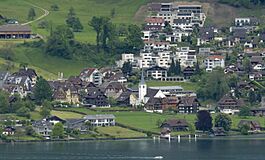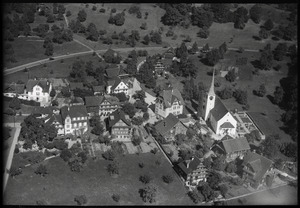Greppen facts for kids
Quick facts for kids
Greppen
|
||
|---|---|---|
 |
||
|
||
| Country | Switzerland | |
| Canton | Lucerne | |
| District | Lucerne | |
| Area | ||
| • Total | 3.32 km2 (1.28 sq mi) | |
| Elevation | 447 m (1,467 ft) | |
| Population
(Dec 2020 )
|
||
| • Total | 1,185 | |
| • Density | 356.9/km2 (924.4/sq mi) | |
| Postal code |
6404
|
|
| Surrounded by | Küssnacht (SZ), Meggen, Weggis | |
Greppen is a small town, also called a municipality, in Switzerland. It is located in the Lucerne district, which is part of the canton of Lucerne.
Greppen sits right at the bottom of the huge Rigi mountain. It's a special place because part of it is separated from the rest of its district by Lake Lucerne. This makes it an "exclave," meaning it's a piece of land that belongs to a larger area but isn't directly connected to it.
Contents
- Greppen's Past: A Look at Its History
- Exploring Greppen's Geography
- Neighbors of Greppen
- Greppen's Population: How It Has Grown
- Greppen's Local Government
- Greppen's Economy: How People Make a Living
- Getting Around: Transportation in Greppen
- Learning in Greppen: Schools
- Things to See and Do in Greppen
- Images for kids
- See also
Greppen's Past: A Look at Its History
Greppen shares a lot of its history with its nearby town, Weggis. The first time Greppen was mentioned, though not directly, was in 1259. Back then, it was called Crepon.
For a long time, Greppen was owned by the Habsburg family. But in 1406, they sold it to Lucerne. Later, in 1803, Greppen officially became part of the Lucerne District.
Exploring Greppen's Geography
Greppen is located on the eastern side of the Küssnacht arm of Lake Lucerne. It's right at the base of the impressive Mount Rigi. The town stretches from the lake up the western side of Mount Rigi, reaching almost to Rigi-Staffel, which is about 1,400 meters (4,593 feet) high.
There's also a special nature preserve in Greppen called the Breitenacherreid. This area helps protect local plants and animals.
Land Use in Greppen
Greppen covers an area of about 3.3 square kilometers (1.3 square miles). A large part of this land, about 50.9%, is used for farming. Forests cover another 39.7% of the area. The remaining 9.4% of the land is where buildings and roads are located.
Most of the farming land is used for crops or pastures. A smaller part is used for growing fruits like grapes or other orchard crops.
Neighbors of Greppen
Greppen shares its borders with the towns of Weggis and Küssnacht. These towns are in the Canton of Schwyz. Greppen also has a water border with Meggen across Lake Lucerne.
Greppen's Population: How It Has Grown
Changes in Population Over Time
In 1798, only 240 people lived in Greppen. The population slowly grew until 1860. After that, it went down for a while, reaching 244 people by 1900.
However, in the next 20 years, tourism became popular, and Greppen's population grew quickly. From 1900 to 1920, it increased by over 50%! The number of people stayed about the same until 1980.
Since 1980, Greppen's population has grown a lot. This is because it's easier to travel there now, the weather is nice, and it's close to bigger cities like Lucerne and Küssnacht. In the last 10 years, the population has grown by 28.2%.
Here's a look at how the population has changed over the years:
| Population Growth | |
|---|---|
| Year | Population |
| 1456 | about 70 |
| 1695 | about 200 |
| 1798 | 240 |
| 1850 | 287 |
| 1860 | 297 |
| 1880 | 244 |
| 1900 | 228 |
| 1910 | 281 |
| 1920 | 346 |
| 1950 | 349 |
| 1980 | 349 |
| 1990 | 567 |
| 2000 | 770 |
| 2004 | 879 |
Languages Spoken in Greppen
In 2000, most people in Greppen, about 94%, spoke German. A smaller number spoke English (1.3%) or French (0.91%).
Religions and Beliefs
Greppen has a long history of being a Catholic community. In 2000, about 66% of the people were Roman Catholic. About 20% were Protestant. Other groups included Orthodox Christians and Old Catholics. Some people were Atheists (8.44%), meaning they don't believe in a god. There were also Muslims and others who didn't state their religion.
Where People Come From
In 2000, most people living in Greppen (about 90%) were Swiss citizens. About 10.9% of the population in 2007 were foreign nationals. These included people from Germany, Italy, France, Austria, and other countries.
Age Groups in Greppen
Greppen has a mix of different age groups. About 26.1% of the population is aged 0–19 years old. Another 25.2% are between 20–39 years old. The largest group, 39%, are between 40–64 years old. Older adults (65 and over) make up about 9.7% of the population.
Homes and Households
In 2000, there were 293 households in Greppen. About 28% of these were single-person households. About 10% were large households with five or more people. Most homes were either two or three stories tall.
Greppen's Local Government
The local government in Greppen is run by a Municipal Council. The members of this council are not full-time politicians.
Local Elections
In the 2007 elections, the most popular political party was the SVP, which received 29.4% of the votes. Other popular parties were the CVP (26.5%) and the FDP (23%).
Working Together: The "Fusion" Project
The three towns near Mount Rigi in the Lucerne District are thinking about joining together. They already work together on many things, so a gradual union could make sense for them.
Greppen's Economy: How People Make a Living
People in Greppen work in many different jobs. In the past, farming (especially cattle and dairy), fishing, and even chestnut growing were important. There were also silk and linen weaving factories, but these are gone now.
Today, major jobs include working in restaurants, tourism, medicine, and construction. Many people who live in Greppen actually travel to other towns for work. For example, about 280 out of 421 employed people commute out of Greppen. They travel to places like Canton Schwyz, Canton Zug, Lucerne, and Weggis.
Greppen has a low unemployment rate, which means most people who want to work can find jobs. In 2005, there were 47 people working in farming and related businesses. Another 35 people worked in manufacturing and construction. The largest group, 69 people, worked in services like tourism and healthcare.
Tourism in Greppen
Tourism is not as big in Greppen as it is in some other nearby towns. This is partly because a planned train line up Mount Rigi from Greppen was never built. However, there are still nice places to visit, including two well-known restaurants called Eidgenossen and St. Wendelin/Fische.
Getting Around: Transportation in Greppen
Greppen has had a ship dock on Lake Lucerne since 1869. This allows people to travel by boat. A bus line was also started in 1932, connecting Küssnacht to Brunnen through Weggis. This bus is important for local public transport.
The closest train station is in Küssnacht, which is on the line from Lucerne to Goldau. There's also a train station in Brunnen.
A major highway exit, about 5 kilometers (3 miles) away in Küssnacht, has made it much easier to get to Greppen by car. This has helped the population grow.
Learning in Greppen: Schools
Greppen has its own primary school that opened in 1809. Students from Kindergarten through grade 6 attend this school. There are 8 students in Kindergarten and 84 students in elementary grades. After grade 6, students go to school in the neighboring town of Weggis.
Most adults in Switzerland are well-educated. In Greppen, about 81.9% of adults (aged 25-64) have finished high school or gone on to higher education, like university.
Things to See and Do in Greppen
In the 14th century, a special religious group called the holy order of St. Wendelin was started in Greppen. A small church, or chapel, dedicated to St. Wendelin was built between 1483 and 1485. This chapel was later replaced by a larger parish church around 1645. Every year on October 20, people make a pilgrimage (a special journey) to Greppen.
Greppen has kept its traditional village feel. Because of this, it has been added to the "Inventory of protected communities," which means its special character is being preserved.
Images for kids
See also
 In Spanish: Greppen para niños
In Spanish: Greppen para niños







